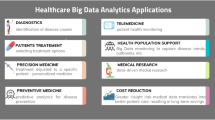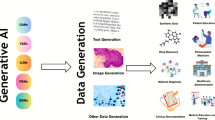Abstract
In this paper, we outline the challenges to integrating patient-centered data into clinical workflow that were encountered during the deployment of a research prototype mobile system, Estrellita, designed to support collection of data about preterm infants and their parents. The data sources for our analysis come from approximately 4 years of collaboration, beginning in March of 2008, between an academic research team and various clinical partners specializing in high-risk infant care. Specifically, we draw from interviews with parents, pediatric health specialists, community pediatricians, and clinicians at a high-risk infant follow-up program; our collaborative experience throughout the project; and observations of one clinician as she integrated patient-generated data into her workflow over an 8-month period. We identified three major challenges to integrating patient-generated data into the clinical workflow: (1) finding an appropriate clinical partner, (2) designing for the unique workflow of the HRIF program, and (3) designing to minimize clinician liability. We further present workflow analysis from one clinician who monitored the patient-generated data. We discuss lessons learned and opportunities for design.



Similar content being viewed by others
Notes
In our study, “parent-generated data” may be a more accurate term, as it is the parents, not the babies, who enter the data into Estrellita. However, because the data are about the babies and because “patient-generated data” is more commonly used in the research literature, we choose to use that term to describe our data.
References
Callanan C, Doyle L, Rickards A et al (2001) Children followed with difficulty: how do they differ? J Paediatr Child Health 37:152–156. doi:10.1046/j.1440-1754.2001.00621.x
Roberts G, Howard K, Spittle AJ et al (2008) Rates of early intervention services in very preterm children with developmental disabilities at age 2 years. J Paediatr Child Health 44:276–280. doi:10.1111/j.1440-1754.2007.01251.x
Campbell MK, Halinda E, Carlyle MJ et al (1993) Factors predictive of follow-up clinic attendance and developmental outcome in a regional cohort of very low birth weight infants. Am J Epidemiol 138:704–713
Slater MA, Naqvi M, Andrew L, Haynes K (1987) Neurodevelopment of monitored versus nonmonitored very low birth weight infants: the importance of family influences. J Dev Behav Pediatr 8:278–285
Greer F (2007) Long-term adverse outcomes of low birth weight, increased somatic growth rates, and alterations of body composition in the premature infant: review of the evidence. J Pediatr Gastroenterol Nutr 45:S147–S151. doi:10.1097/01.mpg.0000302961.01170.29
Greenough A (2008) Long-term pulmonary outcome in the preterm infant. Neonatology 93:324–327. doi:10.1159/000121459
Marlow N, Wolke D, Bracewell M, Samara M (2005) Neurologic and developmental disability at six years of age after extremely preterm birth. Pediatrics 117:940–941. doi:10.1542/peds.2007-0440
Department of Health Care Services and California Perinatal Quality Care Collaboration (2010) High risk infant follow-up quality of care initiative manual of definitions for infants born. 1 Jan 2009
Cameron N, Demerath EW (2002) Critical periods in human growth and their relationship to diseases of aging. Am J Phys Anthropol 119:159–184. doi:10.1002/ajpa.10183
Dietz W (1994) Critical periods in childhood for the development of obesity. Am J Clin Nutr 59:955–959
McCormick MC, Brooks-Gunn J, Buka SL et al (2006) Early intervention in low birth weight premature infants: results at 18 years of age for the Infant Health and Development Program. Pediatrics 117:771–780. doi:10.1542/peds.2005-1316
Olds D (2006) Progress in improving the development of low birth weight newborns. Pediatrics 117:940–941. doi:10.1542/peds.2005-2701
Ramey CT, Bryant DM, Wasik BH et al (1992) Infant health and development program for low birth weight, premature infants: program elements, family participation, and child intelligence. Pediatrics 89:454–465
deSouza N, Patel V, D’Souza P, Rao HB (2000) Determinants of follow-up in an early intervention program in high-risk babies. Indian Pediatr 37:986–989
Fornari V, Sherman M, Lipper E (1984) Parental needs in a neonatal intensive care follow-up clinic. Pediatr Res 18:103A
Tsou K-I, Hsu C-H, Fang L-J et al (2006) Factors affecting the non-compliance for follow-up in very low birth weight children. Acta Paediatr Taiwan 47:284–292
MacDonald H (2002) Perinatal care at the threshold of viability. Pediatrics 110:1024–1027
Blanchet KD (2008) Remote patient monitoring. Telemed e-Health 14:127–130. doi:10.1089/tmj.2008.9989
Kang HG, Mahoney DF, Hoenig H et al (2010) In situ monitoring of health in older adults: technologies and issues. J Am Geriatr Soc 58:1579–1586. doi:10.1111/j.1532-5415.2010.02959.x
Wakefield BJ, Holman JE, Ray A et al (2011) Effectiveness of home telehealth in comorbid diabetes and hypertension: a randomized, controlled trial. Telemed J E Health 17:254–261. doi:10.1089/tmj.2010.0176
Agarwal S, Lau CT (2010) Remote health monitoring using mobile phones and web services. Telemed J E Health 16:603–607. doi:10.1089/tmj.2009.0165
Pekmezaris R, Mitzner I, Pecinka KR et al (2012) The impact of remote patient monitoring (telehealth) upon Medicare beneficiaries with heart failure. Telemed J E Health 18:101–108. doi:10.1089/tmj.2011.0095
Klersy C, De Silvestri A, Gabutti G et al (2011) Economic impact of remote patient monitoring: an integrated economic model derived from a meta-analysis of randomized controlled trials in heart failure. Eur J Heart Fail 13:450–459. doi:10.1093/eurjhf/hfq232
Bostock Y, Hanley J, McGown D et al (2009) The acceptability to patients and professionals of remote blood pressure monitoring using mobile phones. Prim Health Care Res Dev 10:299. doi:10.1017/S1463423609990107
Seto E, Leonard KJ, Masino C et al (2010) Attitudes of heart failure patients and health care providers towards mobile phone-based remote monitoring. J Med Internet Res 12:e55. doi:10.2196/jmir.1627
Liu LS, Hirano SH, Tentori M et al (2011) Improving communication and social support for caregivers of high-risk infants through mobile technologies. In: Proceedings of ACM 2011 conference computing support cooperation work—CSCW’11. ACM Press, New York, NY, USA, pp 475–484. doi:10.1145/1958824.1958897
Tang KP, Hirano SH, Cheng KG, Hayes GR (2012) Balancing caregiver and clinician needs in a mobile health informatics tool for preterm infants. In: Proceedings of 2012 Pervasive Health Conference IEEE, pp 1–8. doi:10.4108/icst.pervasivehealth.2012.248716
Burawoy M (1998) The extended case method. Sociol Theory 16:4–33. doi:10.1111/0735-2751.00040
Gravem D, Lakes KD, Teran L et al (2009) Maternal perceptions of infant exercise in the neonatal intensive care unit. J Obstet Gynecol Neonatal Nurs 38:527–533. doi:10.1111/j.1552-6909.2009.01055.x
McQueen D, Lakes KD, Rich J et al (2013) Feasibility of a caregiver-assisted exercise program for preterm infants. J Perinat Neonatal Nurs 27:184–192. doi:10.1097/JPN.0b013e31828b244a
Hayes GR, Patterson DJ, Singh M et al (2011) Supporting the transition from hospital to home for premature infants using integrated mobile computing and sensor suppory. Pers Ubiquitous Comput 15:871–885. doi:10.1007/s00779-011-0402-4
Earls MF (2010) Incorporating recognition and management of perinatal and postpartum depression into pediatric practice. Pediatrics 126:1032–1039. doi:10.1542/peds.2010-2348
Kavanaugh M, Halterman JS, Montes G et al (2006) Maternal depressive symptoms are adversely associated with prevention practices and parenting behaviors for preschool children. Ambul Pediatr 6:32–37. doi:10.1016/j.ambp.2005.09.002
Chung EK, McCollum KF, Elo IT et al (2004) Maternal depressive symptoms and infant health practices among low-income women. Pediatrics 113:e523–e529. doi:10.1542/peds.113.6.e523
Paulson JF, Dauber S, Leiferman JA (2006) Individual and combined effects of postpartum depression in mothers and fathers on parenting behavior. Pediatrics 118:659–668. doi:10.1542/peds.2005-2948
Vigod S, Villegas L, Dennis CL, Ross L (2010) Prevalence and risk factors for postpartum depression among women with preterm and low-birth-weight infants: a systematic review. BJOG Int J Obstet Gynaecol 117:540–550. doi:10.1111/j.1471-0528.2009.02493.x
Liu LS, Shih PC, Hayes GR (2011) Barriers to the adoption and use of personal health record systems. In: Proceedings of 2011 iConference—iConference’11. ACM Press, New York, NY, USA, pp 363–370. doi:10.1145/1940761.1940811
Author information
Authors and Affiliations
Corresponding author
Rights and permissions
About this article
Cite this article
Cheng, K.G., Hayes, G.R., Hirano, S.H. et al. Challenges of integrating patient-centered data into clinical workflow for care of high-risk infants. Pers Ubiquit Comput 19, 45–57 (2015). https://doi.org/10.1007/s00779-014-0807-y
Received:
Accepted:
Published:
Issue Date:
DOI: https://doi.org/10.1007/s00779-014-0807-y




